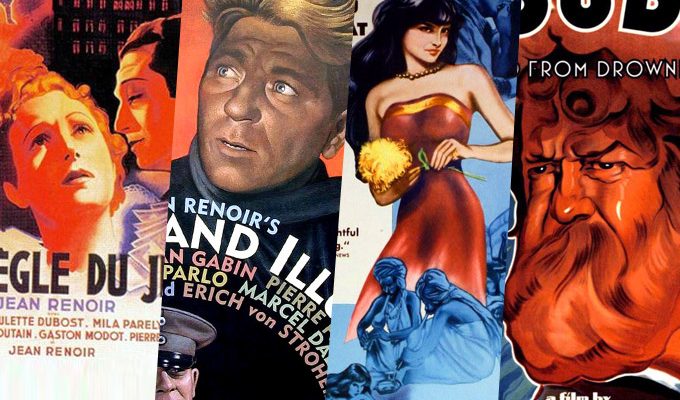
“The Rules of the Game” (1939)
By 1939, Renoir had built up enough clout to do whatever he wanted, and with WWII edging ever closer, he chose to revisit familiar territory for his next project: relationships between classes, but explored in a drastically different and more lighthearted way than his previous picture. By holding a mirror to the various delusions afflicting upper-class society, Renoir created an incredibly energetic tapestry of broken individuals surrounded by disintegrating societal values. The film quickly became the most expensive French production ever up to that point, and was met with scathing criticism when it was released, specifically for not providing the kind of escape French audiences were desperate for (on the contrary, the film directly criticized their way of life). It’s the film that drove Renoir out of France and into the Hollywood system, one that he was forced to cut down into an uncomfortably claustrophobic 85 minutes inviting a record number of negative reviews. It wasn’t until 1956, when the film re-emerged at the Venice Film Festival in its intended form, that “The Rules of the Game” started to garner the kind of admiration which would eventually see it rise in esteem, above all other Renoir pictures. Today, it’s often cited as one of the greatest films ever (safely secured in the top 10 of Sight & Sound’s universal poll for decades), and remains a cinematic cornerstone for social satire. As his most lavish ensemble piece, populated by unforgettable characters like Robert (Marcel Dalio), Christine (Nora Gregor) and Octave (Renoir), and a technically dazzling rabbit hunting sequence that introduced the wondrous effects of deep focus photography to western filmmaking, “The Rules of the Game” embodies what makes Renoir’s perception of the human condition so eternally entertaining in 106 minutes.

“The Southerner” (1945)
Disappointed with the reception of “The Rules of the Game” and driven out of his home country by fascists, Renoir moved to America and entered a shaky period in his career. Of the five films he directed in the 1940s (among them a decent adaptation of “Diary of a Chambermaid”), “The Southerner” contains the most heartwarming resonance and in spirit is most closely connected to the majesty of his bountiful ’30s period, perhaps because it’s the first film Renoir made on American soil without studio interference. It tells the story of the impoverished Tucker family; husband Sam (Zachary Scott), wife Nona (Betty Field), their two young children, and Granny Tucker (Beulah Bondi). Sam is a cotton-picker determined to make his family’s farming life into a prosperous one, but he’s constantly met with obstacles caused by merciless nature or unfriendly neighbours, and that’s not counting the bitter nagging of his mother (Bondi’s crooked expressions are absolutely priceless here). The picture is essential in the Renoir canon for simultaneously being a master filmmaker’s brutally honest depiction of harsh life in The Land of Opportunity and a reflection of the director’s own artistic inclinations at the time. How much World War II and the poison of Nazism changed Renoir’s artistic mood is most readily sensed in his representation of nature (one imagines the Baron from “The Lower Depths” wouldn’t enjoy lying in this grass all that much…). With poignant performances by Scott and Field and Renoir’s camera enlightening the desolate American landscape, “The Southerner” makes up for its minor flaws with heaps of heart.

“The River” (1951)
A reconnaissance trip introduced India to Renoir, and he returned the favor by introducing the enchantment of the country to western audiences. In a place where “the river brings everything,” an adorably superstitious Indian nanny (Suprova Mukerjee) supervises the children of English settlers, and three young girls come of age in Renoir’s most peculiar picture, an adaptation of Rumer Godden‘s novel. Told in a tremendously evocative voice-over by June Hillman, the story centres around the narrator Harriet as a young girl (Patricia Walters), her American friend Valerie (Adrienne Corri) and their Indian-British friend Melanie (Radha), as their quiet lives are gently stirred by the arrival of Captain John (Thomas E. Breen). Of course, this being a Renoir picture, the complete story involves every corner of the frame and a dozen or so supporting and minor characters from various walks of life. Most effectively, the film is a cinematic love letter to India’s rich culture and traditions, where scenes depicting the Hindu Festival of Light, a row of workers carrying jute, or the bustle of an Indian bazaar infuse Renoir’s production with the only element thus far missing in his body of work; marvelous, enriching, vivacious color. The odd structure, where diversions include a story-within-a-story featuring one of the characters from the film and a hypnotic montage of dissolves showing a handful of characters resting peacefully, recalls every Renoir film in which plot and narrative sprout organically, creating a wholly cinematic experience and a serene meditation on love, death, and the continuance of all things. Famously adored by Martin Scorsese, “The River” heralded the final chapter of Renoir’s career and remains his most visually stunning piece of work.
Renoir would continue to work up until the late ’60s, though one can argue that the only two films after “The River” worthy of the “essential” label are “The Golden Coach” (1953) and “French Cancan” (1954, which reunited him with Jean Gabin for one final time). In any case, it is blindingly clear (to use a phrase from ‘Boudu’) that when talking about any picture directed by Jean Renoir, we’re talking about one of the purest masters of the craft. A director of such grandeur that even his least essential film contains within it an entire world alive with a joie de vivre that remains unmatched to this day.

